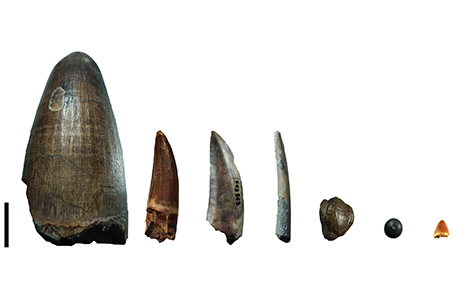Global S&T Development Trend Analysis Platform of Resources and Environment
| The dinosaur menu, as revealed by calcium | |
| admin | |
| 2018-04-11 | |
| 发布年 | 2018 |
| 语种 | 英语 |
| 国家 | 法国 |
| 领域 | 地球科学 |
| 正文(英文) | By studying calcium in fossil remains in deposits in Morocco and Niger, researchers have been able to reconstruct the food chains of the past, thus explaining how so many predators could coexist in the dinosaurs' time. This study, conducted by the Laboratoire de géologie de Lyon : Terre, planètes et environnement (CNRS/ENS de Lyon/Claude Bernard Lyon 1 University), in partnership with the Centre for Research on Palaeobiodiversity and Palaeoenvironments (CNRS/French National Museum of Natural History/Sorbonne University), is published on April 11, 2018 in the Proceedings of the Royal Society of London B.
A hundred million years ago, in North Africa, terrestrial ecosystems were dominated by large predatorsgiant theropod dinosaurs, large crocodileswith comparatively few herbivores. How were so many carnivores able to coexist?
To understand this, French researchers have studied fossils in the Gadoufaoua deposits in Niger (dating from 120 million years ago) and the Kem Kem Beds in Morocco (dating from 100 million years ago). These two sites are characterized by an overabundance of predators compared to the herbivorous dinosaurs found in the locality. More specifically, the researchers measured the proportions of different calcium isotopes1 in the fossilized remains (tooth enamel and fish scales). Among vertebrates, calcium is almost exclusively derived from food. By comparing the isotopic composition of potential prey (fish, herbivores) with that of the carnivores' teeth, it is thus possible to retrace the diet of those carnivores. The data obtained show similar food preferences at the two deposits: some large carnivorous dinosaurs (abelisaurids and carcharodontosaurids) preferred to hunt terrestrial prey such as herbivorous dinosaurs, while others (the spinosaurids) were piscivorous (fish-eating).2 The giant crocodile-like Sarcosuchus had a diet somewhere in between, made up of both terrestrial and aquatic prey. Thus, the different predators avoided competition by subtly sharing food resources. Some exceptional fossils, presenting traces of feeding marks and stomach content, had already provided clues about the diet of dinosaurs. Yet such evidence remains rare. The advantage of the calcium isotope method is that it produces a global panorama of feeding habits at the ecosystem scale. It thus opens avenues for further study of the food chains of the past. This study received support from the Labex Institut des origines de Lyon, the Institut national des sciences de l'Univers, part of the CNRS (through the Diunis project), and the Jurassic Foundation.  © Auguste Hassler / LGL-TPE / CNRS-ENS de Lyon-Université Lyon 1 Teeth from the Gadoufaoua deposit (Niger). The scale bar represents 2 cm. Download the press release:  Notes:1 A chemical element can have different forms, called isotopes, which are differentiated by their mass. Bibliography:Calcium isotopes offer clues on resource partitioning among Cretaceous predatory dinosaurs, Auguste Hassler, Jeremy E. Martin, Romain Amiot, Théo Tacail, Florent Arnaud-Godet, Ronan Allain and Vincent Balter, Proceedings of the Royal Society B, 11 April 2018. View web site Contacts: Researcher l Auguste Hassler l T +33 (0)4 72 72 81 89 l auguste.hassler@ens-lyon.fr |
| URL | 查看原文 |
| 来源平台 | Centre national de la recherche scientifique |
| 文献类型 | 新闻 |
| 条目标识符 | http://119.78.100.173/C666/handle/2XK7JSWQ/107005 |
| 专题 | 地球科学 |
| 推荐引用方式 GB/T 7714 | admin. The dinosaur menu, as revealed by calcium. 2018. |
| 条目包含的文件 | 条目无相关文件。 | |||||
| 个性服务 |
| 推荐该条目 |
| 保存到收藏夹 |
| 查看访问统计 |
| 导出为Endnote文件 |
| 谷歌学术 |
| 谷歌学术中相似的文章 |
| [admin]的文章 |
| 百度学术 |
| 百度学术中相似的文章 |
| [admin]的文章 |
| 必应学术 |
| 必应学术中相似的文章 |
| [admin]的文章 |
| 相关权益政策 |
| 暂无数据 |
| 收藏/分享 |
除非特别说明,本系统中所有内容都受版权保护,并保留所有权利。
修改评论